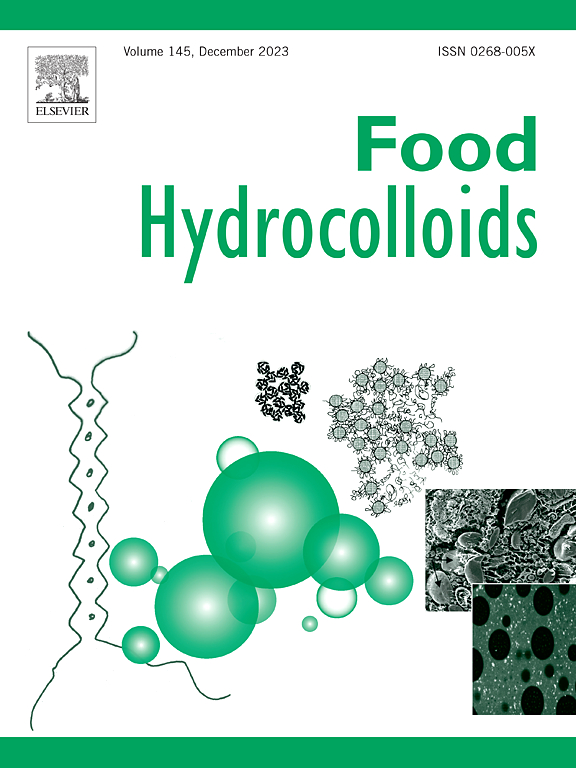The molecular size and water dynamics effects of polyethylene glycol on starch gelatinization properties
IF 11
1区 农林科学
Q1 CHEMISTRY, APPLIED
引用次数: 0
Abstract
The mechanisms by which molecules influence the gelatinization temperature (Tgel) of starch are of both scientific and practical interest, since gelatinization affects the structure, texture, and functionality of starch-containing food and industrial applications. This study was designed to understand how polyethylene glycol (PEG, chosen for its unique physicochemical properties and pure size fractions) affects the gelatinization parameters of normal amylose-containing starches from four botanical sources (wheat, corn, tapioca, and potato) with differing amylopectin fine structures. Sucrose was also studied, since it is more effective at antiplasticizing starch, exhibited by higher Tgels, than many other small molecules which has posed challenges for reducing added sugars in foods. Differential scanning calorimetry was used to measure starch gelatinization in water and 15–45 % w/w solutions of sucrose and PEG molecules ranging in size from 200 to 10,000 g/mol. Solution density, water activity, and dynamic viscosity were also measured, and samples were viewed by confocal image analysis. The Tgels of all starch types were higher in 45 % w/w solutions of all PEGs, regardless of size, than of sucrose. Smaller PEGs (<1000 g/mol, the size exclusion limit of starch granules) increased the Tgel more than the larger PEGs across all starch types and concentrations. Starch structural differences were associated with different extents of Tgel variations and ranges, with cereal starches exhibiting greater variation in the presence of PEG. Smaller PEG resulted in higher Tgels attributed to diffusion into starch granules and resultant stabilization via intermolecular hydrogen bonding. Larger PEG exerted effects on Tgel, even though they were too large to enter the starch granules, by limiting solvent plasticization. The findings highlight how PEGs of different sizes are more effective antiplasticizers of starch than sucrose and elucidate how additive molecular size dictates the gelatinization behavior and, by extension, the end-use properties of starch in food and non-food systems.

聚乙二醇的分子大小和水动力学对淀粉糊化性能的影响
分子影响淀粉糊化温度(Tgel)的机制具有科学和实际意义,因为糊化影响含淀粉食品和工业应用的结构、质地和功能。本研究旨在了解聚乙二醇(PEG,因其独特的物理化学性质和纯尺寸组分而被选择)如何影响具有不同支链淀粉精细结构的四种植物来源(小麦、玉米、木薯和马铃薯)的普通含直链淀粉淀粉的糊化参数。蔗糖也被研究过,因为它在抗塑淀粉方面比其他许多小分子更有效,表现为更高的凝胶,这给减少食品中添加糖带来了挑战。差示扫描量热法用于测量淀粉在水和15 - 45% w/w的蔗糖和PEG分子溶液中的糊化情况,其大小为200至10,000 g/mol。还测量了溶液密度、水活度和动态粘度,并通过共聚焦图像分析观察了样品。所有淀粉类型的凝胶在所有peg的45% w/w溶液中,无论大小,都比蔗糖高。在所有淀粉类型和浓度下,较小的peg (<1000 g/mol,淀粉颗粒的尺寸排除极限)比较大的peg更能提高Tgel。淀粉结构差异与不同程度的Tgel变化和范围有关,谷物淀粉在PEG存在下表现出更大的变化。较小的聚乙二醇导致较高的凝胶,这是由于扩散到淀粉颗粒中,并通过分子间氢键产生稳定。较大的PEG通过限制溶剂的塑化作用对Tgel产生影响,即使它们太大而无法进入淀粉颗粒。研究结果强调了不同大小的聚乙二醇是如何比蔗糖更有效的淀粉抗塑剂,并阐明了添加剂分子大小如何决定糊化行为,进而决定淀粉在食品和非食品体系中的最终用途。
本文章由计算机程序翻译,如有差异,请以英文原文为准。
求助全文
约1分钟内获得全文
求助全文
来源期刊

Food Hydrocolloids
工程技术-食品科技
CiteScore
19.90
自引率
14.00%
发文量
871
审稿时长
37 days
期刊介绍:
Food Hydrocolloids publishes original and innovative research focused on the characterization, functional properties, and applications of hydrocolloid materials used in food products. These hydrocolloids, defined as polysaccharides and proteins of commercial importance, are added to control aspects such as texture, stability, rheology, and sensory properties. The research's primary emphasis should be on the hydrocolloids themselves, with thorough descriptions of their source, nature, and physicochemical characteristics. Manuscripts are expected to clearly outline specific aims and objectives, include a fundamental discussion of research findings at the molecular level, and address the significance of the results. Studies on hydrocolloids in complex formulations should concentrate on their overall properties and mechanisms of action, while simple formulation development studies may not be considered for publication.
The main areas of interest are:
-Chemical and physicochemical characterisation
Thermal properties including glass transitions and conformational changes-
Rheological properties including viscosity, viscoelastic properties and gelation behaviour-
The influence on organoleptic properties-
Interfacial properties including stabilisation of dispersions, emulsions and foams-
Film forming properties with application to edible films and active packaging-
Encapsulation and controlled release of active compounds-
The influence on health including their role as dietary fibre-
Manipulation of hydrocolloid structure and functionality through chemical, biochemical and physical processes-
New hydrocolloids and hydrocolloid sources of commercial potential.
The Journal also publishes Review articles that provide an overview of the latest developments in topics of specific interest to researchers in this field of activity.
 求助内容:
求助内容: 应助结果提醒方式:
应助结果提醒方式:


